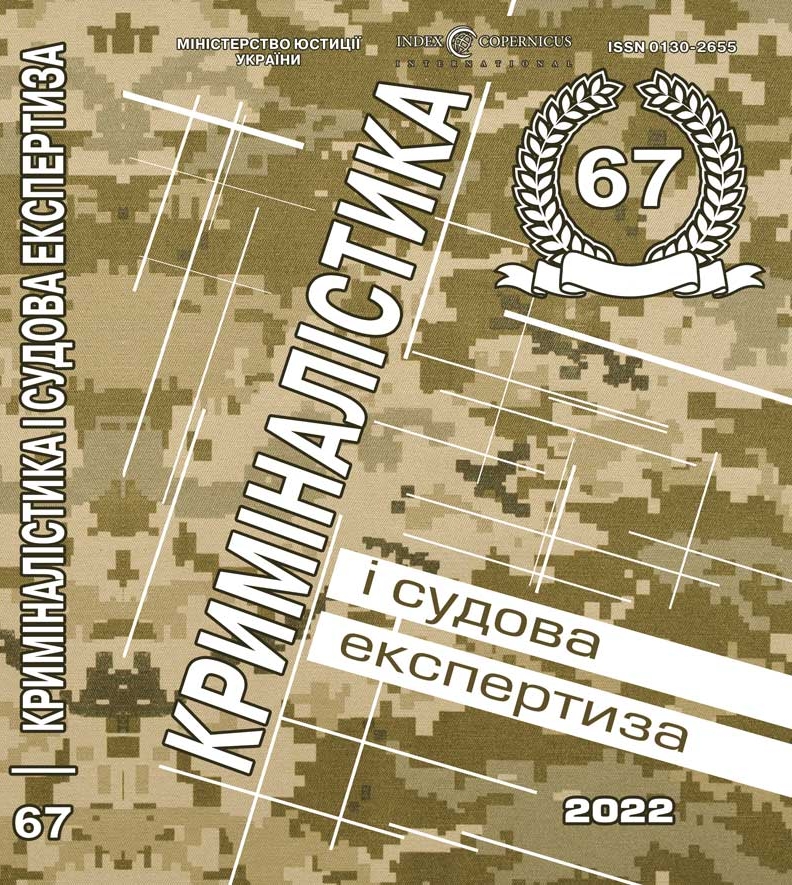
DOI: https://doi.org/10.33994/kndise.2022.67.61
О. Sadchenko, О. Shevchenko
The analysis of the practice of using special commodity knowledge shows that for research at the present level it is necessary to develop theoretical problems, among which the classification of forensic examinations is relevant. The authors offer their own classification of forensic examinations on various grounds.
1. According to the degree of generalization, subordination, forensic examinations should be divided into: class, genera, species and subspecies.
Class: commodity examinations. Types: a) commodity examination of food products; b) commodity examination of non-food products; c) commodity examination of works and services.
Types (subspecies): a) commodity examination of food products is divided into:
– examination of goods of plant origin;
– examination of goods of animal origin;
– examination of goods of mixed origin. b) commodity examination of non-food (industrial) goods is divided into: – examination of consumer goods (consumer goods); – transport and commodity examination (auto commodity; examination of military vehicles; examination of vessels; examination of aircraft); – examination of machines, equipment, raw materials (examination of military property, machinery and weapons); – examination of real estate, real estate (examination of integral property complexes; examination of buildings; expert monetary valuation of land plots (shares)); – examination of cultural values; – examination of objects of painting and applied arts (examination of objects of painting and graphics; examination of sculpture; examination of objects of folk crafts; examination of objects of table setting, etc.); – examination of watches; – examination of securities goods; – examination of goods of property rights to intellectual property (examination of audiovisual products and software); – examination of clothing (examination of knitwear; examination of garments; examination of textiles; examination of fur products; examination of leather products; examination of outerwear, etc.); – examination of fur products; – examination of perfumery and cosmetics; – examination of shoes; – examination of haberdashery (examination of leather haberdashery); – examination of household appliances (examination of photo, radio and video equipment; examination of computers; examination of household electric lighting, etc.); – examination of furniture products; – examination of facilities (livestock, poultry and other live animals); – examination of goods of the construction group; – examination of printed products (examination of books and printing products, etc.); – examination of jewelry (examination of articles of precious metals; examination of articles of precious stones); – examination of stationery; – examination of medical equipment; c) commodity examination of services.
2. Classification of forensic commodity examinations by type of problem to be solved: – commodity examination, to solve classification problems (determination (establishment) of compliance: commodity characteristics of the studied objects with basic data (registers, etc.), data of similar products, marking data recorded on labels or tags, belonging to the same type or article); – commodity examination, to solve diagnostic problems (establishment: the presence of defects and their impact on product quality; compliance (non-compliance) of quality characteristics of products with standard and reference requirements; factual data related to compliance (non-compliance) with the rules of packaging, labeling, storage, transportation, rejection, revaluation and reduction of the price of goods).
3. Classification of forensic commodity examinations by type of object under study: – commodity examination, the objects of research of which are directly only products (commodity origin); – commodity examination, the objects of research of which are only documents (they reflect the state of the goods, the processes that took place with it, commodity transactions, etc.) (circulating name– “examination of documents”); – commodity examination, the objects of study of which are mixed objects (products; samples of products; documents which reflect information about the peculiarities of the origin of goods (certificates, quality certificates, technical passports, labels, etc.), freight (shipping) documents, acceptance or warehouse documents, claim materials, etc.).
Key words: forensic examination, classification of forensic examinations, special commodity knowledge, commodity specialist, examination of food and non-food
products.










